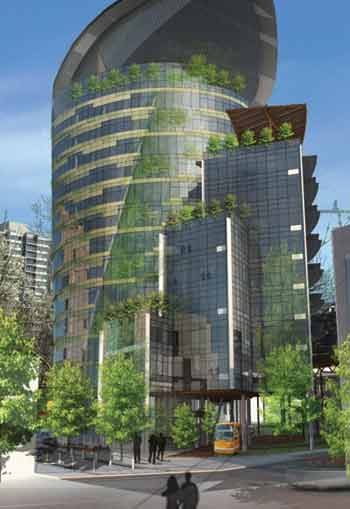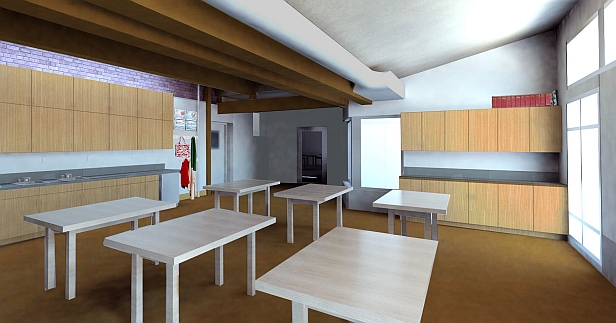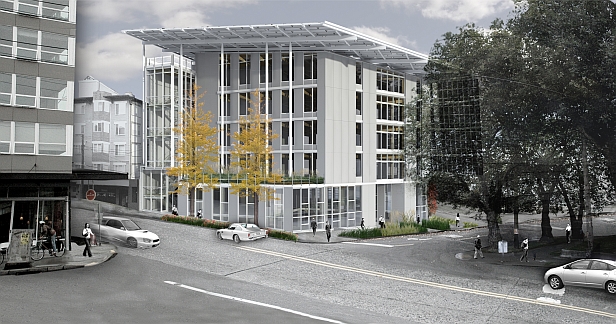 McLennanPhoto: Isaac HernandezFour years ago, Seattle architect Jason McLennan introduced the Living Building Challenge, posing the question, “What if every single act of design and construction made the world a better place?” McLennan proposed a building standard that calls for new structures to produce all of their own energy and use only water that falls on-site. Builders must use sustainably sourced materials and avoid a “red list” of toxic materials including asbestos, mercury, and PVC. They must build on previously developed, sites and meet measurements of livability, social equity, and beauty.
McLennanPhoto: Isaac HernandezFour years ago, Seattle architect Jason McLennan introduced the Living Building Challenge, posing the question, “What if every single act of design and construction made the world a better place?” McLennan proposed a building standard that calls for new structures to produce all of their own energy and use only water that falls on-site. Builders must use sustainably sourced materials and avoid a “red list” of toxic materials including asbestos, mercury, and PVC. They must build on previously developed, sites and meet measurements of livability, social equity, and beauty.
The Living Building Challenge’s seven performance standards – which McLennan calls “petals,” evoking the elegance and efficiency of a flower — are far more demanding than even the highest level of LEED, the most widespread green building certification. McLennan knows that the vast majority of developers will go about their business as usual. Yet 70-some projects are striving to rise to the Living Buildings standard, including the 11-story Oregon Sustainability Center in Portland and the Bullitt Foundation building in Seattle (none has been completed and certified thus far). I chatted recently with McLennan, CEO of the Cascadia Region Green Building Council, about the green building movement he’s working to build.
Q. There were already green building standards, most notably LEED, when you launched the Living Building Challenge in 2006. What was the need for a new, much more stringent standard?
A. There was — and continues to be — no standard that helps people understand where we ultimately need to head. For the most part, green building standards are all about helping you become a little less bad. Given what we know about environmental issues around the globe, we need to move much quicker.
We did this as a way of changing the nature of this discussion, to motivate the leading thinkers to push further faster. It’s a certification program, but it’s also a philosophy, and a market-changing tool, and an advocacy tool. It was the classic reason you put something on the market: because there is nothing quite like it out there.
 A rendering of the Bullitt Foundation’s Cascadia Center for Sustainable Design and Construction planned for Seattle’s Central District.Image: Miller-Hull
A rendering of the Bullitt Foundation’s Cascadia Center for Sustainable Design and Construction planned for Seattle’s Central District.Image: Miller-Hull
Q. If climate change is our most pressing ecological threat, one could argue that energy should trump just about every other consideration for buildings. But it’s just one of the seven performance areas, or “petals,” in your standard.
A. Yeah, but we require net zero energy for all buildings, which is not a small thing to achieve.
We agree that climate change is our paramount, signal issue. But that doesn’t mean that other issues are not important, or that they may prove to be less important in the long run. History is filled with examples of things we thought were the top priority turning out not to be the top. In fact, what the environmental movement should teach us above all else is that the moment we take a singular view and try to solve a problem in isolation, that’s the moment we cause problems for ourselves in other areas.
Q. One complaint about LEED is that it doesn’t give enough priority to where a structure is actually sited — walkable, compact areas versus car-dependent places. How did you approach your location requirement?
A. We don’t allow new sites. You have to build on previously developed places — either brownfields or grayfields. We’re basically saying if it wasn’t developed by 2007, then it’s off-limits. So all farmland stays farmland, all forest land stays forest land, etc. There are always exceptions in life, so there are exceptions in this system, but for 99 percent of projects this holds true. Our cities are filled with underdeveloped sites and poorly developed buildings. It’s time for them to be properly developed. We have enough land – we don’t need to expand anymore.
We also have another big imperative for car-free living. It’s not saying you can’t have a car, but that every decision on a development has to move us toward the ability to have a car-free society. So the project cannot lower the density of a site. If you tear down a ten-story building, you can’t replace it with a two-story building.
 A rendering of the Oregon Sustainability Center planned at Portland State UniversityImage: oregonsustainabilitycenter.orgQ. Does that make for a very urban, centralized focus?
A rendering of the Oregon Sustainability Center planned at Portland State UniversityImage: oregonsustainabilitycenter.orgQ. Does that make for a very urban, centralized focus?
A. There’s a big, important place in our society for towns and villages. It’s not just super-cities. That’s important when you start thinking about food. But we do need to stop building on farmland and the few wild places that remain.
Q. The third area I wanted to talk about is toxics. There’s a tendency to see the climate threat as distinct from environmental health issues, but it sounds like you want to approach them all together.
A. We have to tackle it all together. The point of our whole movement is to create abundance of life, and a healthy ecosystem for all future generations. We have a current industrial system where nobody knows what’s in our materials, and there’s no plan for where they go with those chemicals when their lifespan is over. That’s a pretty bad system. So as long as we need to eat and breathe, toxics should be an important thing to watch for. And our list is not long enough, in any sense.
It’s also strategic: We’re trying to pick on a certain group of chemicals that don’t have to be in our building materials and are particularly nasty. Over time, we’ll add to our list. I hope these things are all banned just like we’ve banned certain things like asbestos and lead. But we haven’t even really abandoned asbestos and lead, we’ve just abandoned some applications.
Q. You’ve also got an imperative for beauty — how does that work?
A. We are trying to make sure that people want Living Buildings, that they want solar buildings, and they want to build energy efficiency. For that to happen they have to be attracted to the s
olutions. The best technology in the world is useless if it’s not implemented. So people have to be demanding this stuff.
We can look at setbacks from the 1970s on really innovative technologies and designs that were just really bad to look at, and uncomfortable to be in. Designers didn’t always understand that people need to be comfortable while they’re doing the right thing, and they need to like it. It set the movement back as it turned a lot of people off. So we include ‘good design’ and beauty as part of a holistic framework. Sometimes the most important things are things that are not easily measured.
 A rendering of a Living Building science classroom at the Bertschi School in SeattleImage: Chris Hellstern and Stacy Smedley, KMD ArchitectsQ. So who decides if a building makes the cut for beauty?
A rendering of a Living Building science classroom at the Bertschi School in SeattleImage: Chris Hellstern and Stacy Smedley, KMD ArchitectsQ. So who decides if a building makes the cut for beauty?
A. We’re not actually judging beauty. We’re bringing up beauty as a topic that is important. So the architect and owner have to write essays that describe why this building is beautiful, what was done to create a wonderful place. Then the occupants of the building also have to weigh in. It changes the nature of the discussion. We’re saying these issues matter, and even if we don’t know how to measure them.
Q. So who takes on this challenge? How many current projects are underway?
A. A surprisingly large number of people. The number is in the 70s, with some attrition and some new projects coming up. There are a lot of projects that don’t register because they want to see how far they can get before they register. Or they don’t register in case they fail, they don’t want it to be known. So the real number is considerably higher than 70.
It tends to be people who get the problem and the challenge that we’re in, and they want to be a part of a solution. We certainly get those who see this as a big marketing opportunity. There are already so many LEED buildings, so how do you distinguish yourself by going further? I mean, Americans love a healthy competition. There are a lot of people who read about it and say, ‘Yeah, this is how we should be doing building. And if we don’t achieve it all, at least we tried.’



